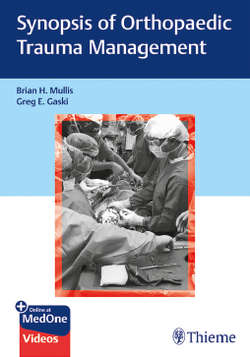Читать книгу Synopsis of Orthopaedic Trauma Management - Brian H. Mullis - Страница 70
III. Treatment/Interventions
ОглавлениеA. Initial management
1. In the face of chaos, it is critical for the physician to obtain and maintain control.
2. Traditional resuscitation efforts are changing. More trauma centers are replacing blood loss with blood products, including whole blood.
3. Thromboelastography (TEG) is more commonly being used at trauma centers for guided resuscitation and treatment of coagulopathy.
4. Persistent hemodynamic instability and evidence of intra-abdominal or intrathoracic injury: emergent exploratory laparotomy.
5. Life-threatening head injuries and intracranial bleeding—emergent craniotomy.
6. Mangled extremities—urgent surgery for:
a. Hemorrhage control, wound debridement, and temporary skeletal stabilization for potentially salvageable injuries.
b. Amputation, if the limb is nonsalvageable.
Fig. 9.2 (a) Application of pelvic binder and resuscitative endovascular balloon occlusion of the aorta (REBOA) catheter for open volume-expanding pelvic ring. (b) REBOA—a catheter is inserted via the femoral artery and introduced into aorta. A balloon is inflated to occlude the aorta and allow for distal control of hemorrhage.
7. Impending or active compartment syndrome—emergent fasciotomies.
8. Embolization in the interventional radiology suite may be appropriate for patients with solid organ injury or pelvic fractures with active extravasation noted on CT.
9. Occasionally, patients will benefit from both exploratory laparotomy as well as angioembolization.
10. Resuscitative endovascular balloon occlusion of the aorta (REBOA)—it is an emerging technology. Catheter is inserted via femoral artery and introduced into aorta. Balloon can be inflated to partially or completely occlude aorta and allow for distal control of hemorrhage. Functionally, an “internal tourniquet” (▶Fig. 9.2a, b).
11. Dislocations should be urgently reduced. Irreducible dislocations should go to the operating room for an open reduction to decrease likelihood of soft tissue or neurovascular compromise.
12. Open fractures can be provisionally treated in the emergency room (ER).
a. Early appropriate antibiotic coverage is critical.
b. Gross contamination can be removed in the ER.
c. Irrigation with sterile saline can be performed, along with application of sterile dressings.
d. Photographs, where institutionally and regionally appropriate, may improve communication between providers.
e. Splint and/or traction can decrease additional soft tissue damage.
13. Skeletal traction may be appropriate for femur fractures, acetabular fractures, vertically unstable pelvic fractures, and hip dislocations.
a. Distal femur versus proximal tibial traction pin is patient-, injury-, and practitioner-specific.
b. The size of the traction pin (5-mm pin vs tensioned 2.0-mm wire) is debatable and institution-/practitioner-dependent.
c. If proximal tibia is selected, care must be taken to ensure there are no knee ligamentous injuries.
d. Skeletal traction may be indicated when patients with femur fractures cannot be definitely managed in an expeditious manner.
14. Application of a pelvic binder or sheet is appropriate for volume-expanding, unstable pelvic ring injuries.
a. A well-placed binder will decrease the pelvic volume, reduce anterior-posterior compression (APC)-type injuries, decrease pain, stabilize the blood clot, and potentially limit blood loss.
b. The binder can be left in place until the patient is stabilized for either internal or external fixation (▶Fig. 9.2a).
c. Some surgeons advocate removing the binder within 24 hours to minimize the risk of soft-tissue necrosis. Consider removing the binder in surgery at the time of skeletal stabilization (external fixation and/or internal fixation).
